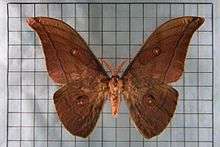Antheraea yamamai
| Antheraea yamamai | |
|---|---|
| Living adult | |
 | |
| Antheraea yamamai superba | |
| Scientific classification | |
| Kingdom: | Animalia |
| Phylum: | Arthropoda |
| Class: | Insecta |
| Order: | Lepidoptera |
| Family: | Saturniidae |
| Tribe: | Saturniini |
| Genus: | Antheraea |
| Species: | A. yamamai |
| Binomial name | |
| Antheraea yamamai Guérin-Méneville, 1861 | |
| Synonyms | |
| |
The Japanese silk moth or Japanese oak silkmoth (Antheraea yamamai, Japanese: Yamamayu(ga) (山繭(蛾)・ヤママユ(ガ)) or tensan (天蚕)) is a moth of the Saturniidae family. It is endemic to east Asia, but has been imported to Europe for Tussar silk production and is now found in southeastern Europe, mainly in Austria, northeastern Italy, and the Balkans. It seems to be spreading north and a population near Deggendorf and Passau (Bayern) has been reported.[1] It has been hybridized artificially with Antheraea polyphemus of North America.[2]
This moth has been cultivated in Japan for more than 1000 years. It produces a naturally white silk but does not dye well, although it is very strong and elastic. It is now very rare and expensive.[3]
The wingspan is 110–150 millimetres (4.3–5.9 in). Adults are on wing from August to September in one generation depending on the location.
The larva mainly feed on Quercus species, but have also been reported on Fagus sylvatica, Castanea sativa, Carpinus, Rosa, and Crataegus.
Subspecies
- Antheraea yamamai yamamai
- Antheraea yamamai bergmani Bryk, 1949
- Antheraea yamamai titan Mell, 1958
- Antheraea yamamai ussuriensis Schachbazov, 1953
- Antheraea yamamai superba Inoue, 1964 (Taiwan)
References
- ↑ "Deggendorf and Passau report" (PDF). Archived from the original (PDF) on October 7, 2011. Retrieved October 18, 2011.
- ↑ See Antheraea polyphemus, Gary Botting
- ↑ "Information sheet". United Nations FAO. Archived from the original on 2012-10-21.
External links
| Wikimedia Commons has media related to Antheraea yamamai. |
| Wikispecies has information related to Antheraea yamamai |